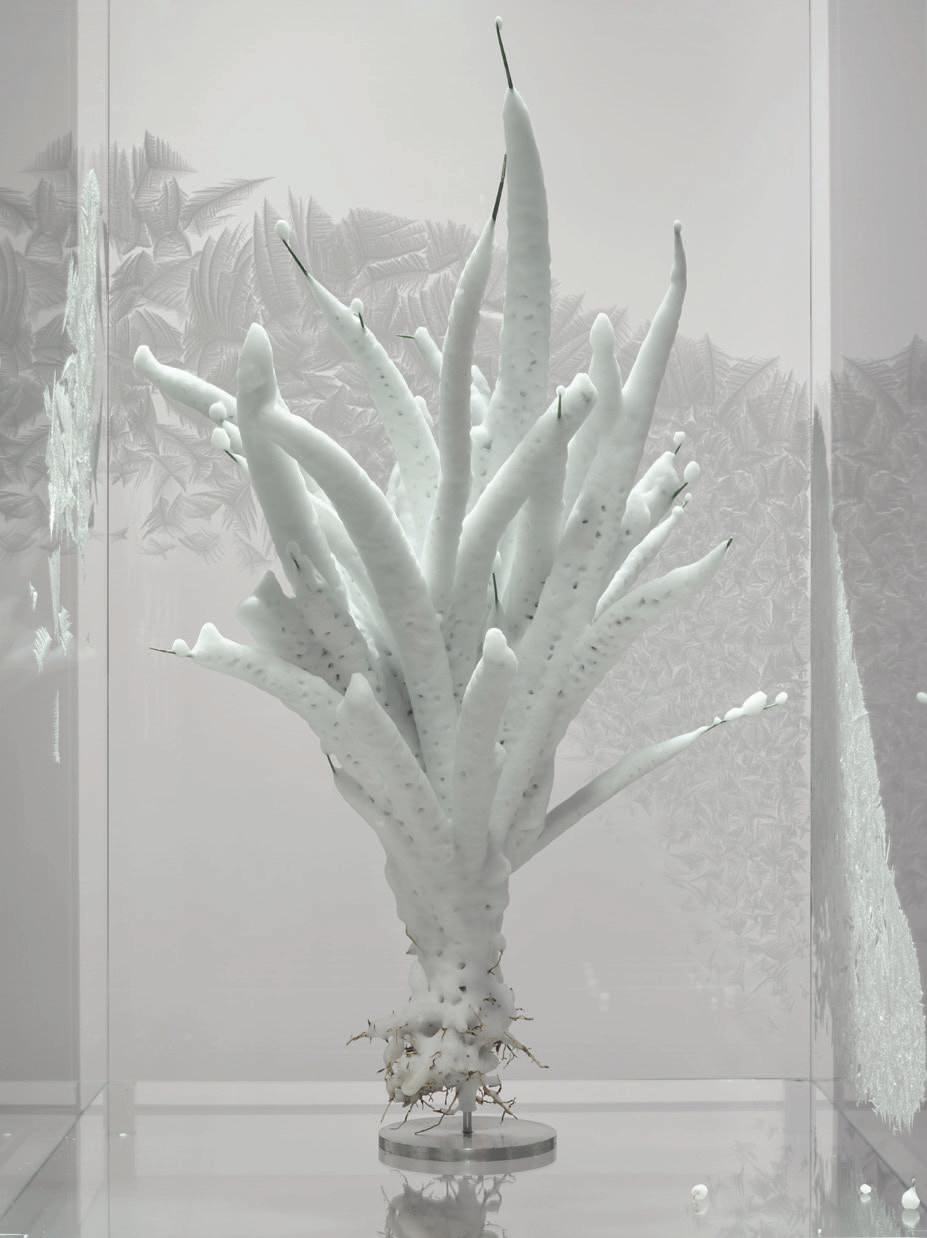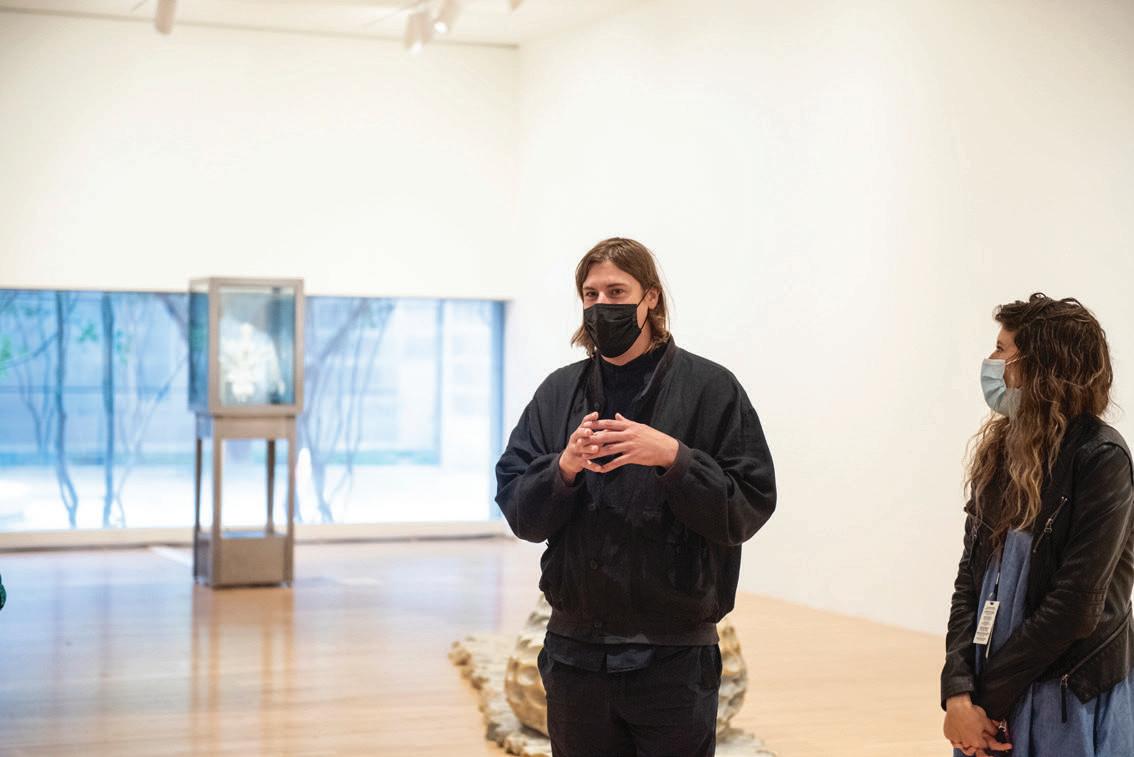
3 minute read
BEYOND SCOPE
French-Swiss artist Julian Charrière addresses the immeasurable burden of humans on remote landscapes.
BY KIT FREEMAN
Advertisement
Julian Charrière, Towards No Earthly Pole (film still), 2019, 4K film, color, sound. Copyright the artist; VG Bild-Kunst, Bonn, Germany.


The compelling inaugural US solo museum exhibition of Berlinbased French-Swiss artist Julian Charrière is on view at the Dallas Museum of Art through August 8, 2021. Concentrations 63: Julian Charrière, Towards No Earthly Pole continues the 40th anniversary of the exhibition series Concentrations, which features emerging international artists.
Charrière’s work examines the bearing of human life on natural landscapes, specifically at extreme climates. Exploring remote locations across the globe, the artist brings together sculpture and image to depict an irreversible change. Also displayed in Concentrations 63 are photos of ice caps and glaciers, overwhelming in size as figures are swallowed by shadows and the blinding whiteness of ice.
Contrasting geological time scales and post-romantic ideals of nature, Charrière utilizes performance, sculpture, and mixed media to illustrate views on environmental science and cultural history through expeditions to remote regions. His work encapsulates the viewer’s fearful yet questioning understanding of Earth and reflects on the quest to comprehend it.
Magnificent in nature, the settlements the artist portrays are rugged, dark, and cinematic. The Blue Fossil Entropic Stories photographs juxtapose the tundra environment of his sculptures with a deafening loneliness, depicting isolation, lost, and fear with sharp angles. Alongside the icy space is a projector, a video for which Charrière set a fountain aflame. And Beneath It All Flows Liquid Fire (2019) records the clashing elements of fire and water. The flames move wildly, reminding the viewer of the mobility of the planet and how the environment can shift at ease at the cost of humanity.
Not All Who Wander are Lost is the first work of the exhibition. Through Charrière’s technical handling, his sculpture looks ice-like and cold to the touch. Cast and drilled with holes, the sensitivity of the sculpture represents how the world is shifting due to human interaction. The core-drilled sculpture is a stone glacial rock, welcoming the viewer into the world’s landscapes and fissures. Charrière, through his work, recounts his time in the polar region, sampling and researching the ways in which ice, rock, and water form.
The exhibition explores the melancholic state of nature in the human era, grappling with the environment and imagination. As the viewer enters a dark room a stirring film of a glacier rock invokes a sublime feeling of the Arctic, imagination, and visual contemplation. Towards No Earthly Pole is a 2019 film running 104 minutes. A defining image of the Anthropocene, the current geological age, and polar snowcaps, the moving picture captures the mystery and power of the effects of global warming. Charrière’s film comprises drone footage of the Alps, Iceland, and Greenland. The film, larger than the viewer, emphasizes the scope, majestic beauty, and timeworn nature of the glacial caps. Charrière describes the work in the exhibition text as demonstrating “a shift in the mode of representation by depicting a place that has been overly exposed in another light.”
“Julian’s work points to the rapid acceleration of the timeline of such natural phenomena,” says Dr. Anna Katherine Brodbeck, the DMA’s Hoffman Family Senior Curator of Contemporary Art, about the new acquisition Not All Who Wander Are Lost. She remarks that Charrière’s sculptures represent the “erratic” nature of the unusual occurrences of the natural world. Since beginning her time at the Dallas Museum of Art, Brodbeck has curated and organized major exhibitions and programs, including the survey exhibition Jonas Wood (2019), America Will Be! Surveying the Contemporary Landscape (2020), and For A Dreamer of Houses (2020–2021).
In reflecting on the exhibition, Brodbeck states, “Charrière’s work is a powerful visual reminder of what we know and what we don’t know about our relationship to the Earth.” P



From top: Julian Charrière, And Beneath It All Flows Liquid Fire (video still), 2019, UHD video, color, sound. Copyright the artist; VG Bild-Kunst, Bonn, Germany; Julian Charrière, Tropisme, 2016, cryogenized plants, refrigerated showcase. Installation view, For They That Sow The Wind, Parisol Unit, London, United Kingdom, 2016. Copyright the artist; VG Vild-Kunst, Bonn, Germany; Julian Charrière and Dr. Anna Katherine Brodbeck, DMA Hoffman Family Senior Curator of Contemporary Art. Photograph by Tamytha Cameron.









